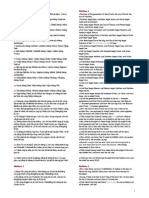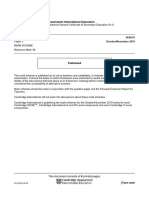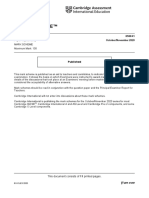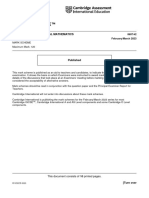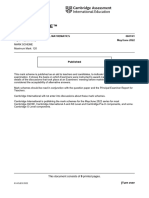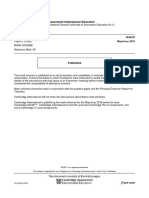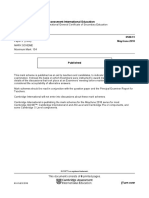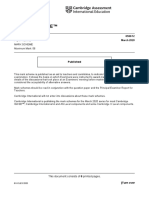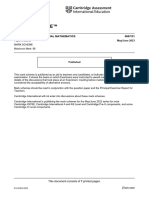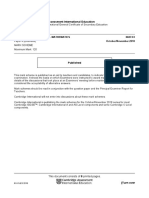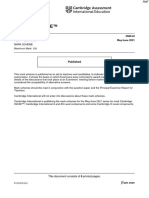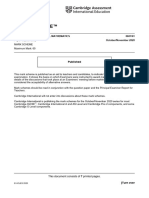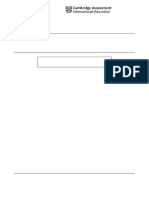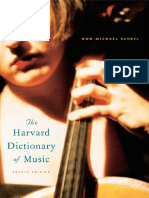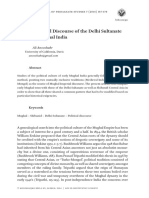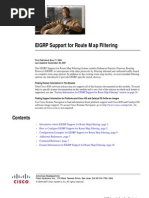Cambridge Assessment International Education: Mathematics 0580/42 March 2019
Cambridge Assessment International Education: Mathematics 0580/42 March 2019
Uploaded by
Ainalnaem GhidariCopyright:
Available Formats
Cambridge Assessment International Education: Mathematics 0580/42 March 2019
Cambridge Assessment International Education: Mathematics 0580/42 March 2019
Uploaded by
Ainalnaem GhidariOriginal Title
Copyright
Available Formats
Share this document
Did you find this document useful?
Is this content inappropriate?
Copyright:
Available Formats
Cambridge Assessment International Education: Mathematics 0580/42 March 2019
Cambridge Assessment International Education: Mathematics 0580/42 March 2019
Uploaded by
Ainalnaem GhidariCopyright:
Available Formats
www.dynamicpapers.
com
Cambridge Assessment International Education
Cambridge International General Certificate of Secondary Education
MATHEMATICS 0580/42
Paper 4 (Extended) March 2019
MARK SCHEME
Maximum Mark: 130
Published
This mark scheme is published as an aid to teachers and candidates, to indicate the requirements of the
examination. It shows the basis on which Examiners were instructed to award marks. It does not indicate the
details of the discussions that took place at an Examiners’ meeting before marking began, which would have
considered the acceptability of alternative answers.
Mark schemes should be read in conjunction with the question paper and the Principal Examiner Report for
Teachers.
Cambridge International will not enter into discussions about these mark schemes.
Cambridge International is publishing the mark schemes for the March 2019 series for most Cambridge
IGCSE™, Cambridge International A and AS Level components and some Cambridge O Level components.
This document consists of 8 printed pages.
© UCLES 2019 [Turn over
0580/42 www.dynamicpapers.com
Cambridge IGCSE – Mark Scheme March 2019
PUBLISHED
Generic Marking Principles
These general marking principles must be applied by all examiners when marking candidate answers.
They should be applied alongside the specific content of the mark scheme or generic level descriptors
for a question. Each question paper and mark scheme will also comply with these marking principles.
GENERIC MARKING PRINCIPLE 1:
Marks must be awarded in line with:
• the specific content of the mark scheme or the generic level descriptors for the question
• the specific skills defined in the mark scheme or in the generic level descriptors for the question
• the standard of response required by a candidate as exemplified by the standardisation scripts.
GENERIC MARKING PRINCIPLE 2:
Marks awarded are always whole marks (not half marks, or other fractions).
GENERIC MARKING PRINCIPLE 3:
Marks must be awarded positively:
• marks are awarded for correct/valid answers, as defined in the mark scheme. However, credit
is given for valid answers which go beyond the scope of the syllabus and mark scheme,
referring to your Team Leader as appropriate
• marks are awarded when candidates clearly demonstrate what they know and can do
• marks are not deducted for errors
• marks are not deducted for omissions
• answers should only be judged on the quality of spelling, punctuation and grammar when these
features are specifically assessed by the question as indicated by the mark scheme. The
meaning, however, should be unambiguous.
GENERIC MARKING PRINCIPLE 4:
Rules must be applied consistently e.g. in situations where candidates have not followed
instructions or in the application of generic level descriptors.
GENERIC MARKING PRINCIPLE 5:
Marks should be awarded using the full range of marks defined in the mark scheme for the question
(however; the use of the full mark range may be limited according to the quality of the candidate
responses seen).
GENERIC MARKING PRINCIPLE 6:
Marks awarded are based solely on the requirements as defined in the mark scheme. Marks should
not be awarded with grade thresholds or grade descriptors in mind.
© UCLES 2019 Page 2 of 8
0580/42 www.dynamicpapers.com
Cambridge IGCSE – Mark Scheme March 2019
PUBLISHED
Abbreviations
cao correct answer only
dep dependent
FT follow through after error
isw ignore subsequent working
oe or equivalent
SC Special Case
nfww not from wrong working
soi seen or implied
Question Answer Marks Partial Marks
1(a) 473 2 M1 for 645 ÷ (11 + 4)
1(b) 212.5 2 M1 for 50 × 4.25
1(c) 31.5 or 31.45 to 31.46 3 43
M2 for 54 ÷ 1 oe
60
or M1 for time =1h 43min or 103 [mins]
or 54 ÷ their time
1(d) 875 1
1(e) 10.4 or 10.38 to 10.39 1
1(f)(i) 30 [×] 70 and 2100 1
1(f)(ii) both numbers rounded up oe 1
2(a)(i) Reflection 2 B1 for each
x = 1.5
2(a)(ii) Rotation 3 B1 for each
(0, −1)
90° [anticlockwise] oe
2(b)(i) Image at (5, −1) (6, −1) (6, −3) 2 B1 for correct size and orientation but
wrong position
1
If 0 scored, SC1 for enlargement SF
2
with centre (3, 0)
2(b)(ii) Image at (−6, 3) (−4, 3) (−6, 7) 2 −3 k
B1 for translation or
k 1
2(b)(iii) Image at (2, −1) (2, −3) (6, −3) 3 M2 for 3 correct coordinates soi
0 1 −1 −3 −3
or M1 for
1 0 2 2 6
or B1 for stating reflection in y = x
© UCLES 2019 Page 3 of 8
0580/42 www.dynamicpapers.com
Cambridge IGCSE – Mark Scheme March 2019
PUBLISHED
Question Answer Marks Partial Marks
3(a) 5 1
oe
9
3(b) 80 3 10 8
oe M2 for 2 × × oe
153 18 17
10 8
or M1 for × oe
18 17
160
If 0 scored, SC1 for oe
324
3(c) 11 4 10 9 8 8 7 6
oe M3 for × × + × × oe
51 18 17 16 18 17 16
10 9 8 8 7 6
or M2 for × × oe or × ×
18 17 16 18 17 16
oe
10 9 8 8 7 6
or M1 for , , or , ,
18 17 16 18 17 16
1512
If 0 scored, SC1 for oe
5832
4(a) Correct ruled line with D marked 2 B1 for correct ruled line or short line
4(b) 47.5 2 B1 for 9.5 or 95 mm seen or for answer
figs 465 to figs 485
4(c) Correct arc radius 7 cm 2 B1 for complete arc other radius, centre A
or correct but short arc
Correct ruled perpendicular bisector of 2 B1 for correct perpendicular bisector
BC with correct pairs of arcs without correct arcs
or for correct arcs, no/incorrect line
Correct ruled bisector of angle BCD with 2 B1 for correct angle bisector without
correct pairs of arcs correct arcs
or for correct arcs, no/incorrect line
correct region shaded 1 Dep on at least B1B1B1 and five
boundaries one of which is an arc
4(d) [1 :] 500 1
© UCLES 2019 Page 4 of 8
0580/42 www.dynamicpapers.com
Cambridge IGCSE – Mark Scheme March 2019
PUBLISHED
Question Answer Marks Partial Marks
5(a) −2.1, 1.6, −1.7, 2.1 3 B2 for 3 correct
or B1 for 2 correct
5(b) Fully correct curve 4 B3FT for 8 or 9 correct plots
or B2FT for 6 or 7 correct plots
or B1FT for 4 or 5 correct plots
5(c) 1 M2 1
line y = (1 − x ) ruled M1 for line with gradient −
2 2
1 1
M1 for line through (0, ) but not y =
2 2
−2.15 to −2.01 B2 B1 for two correct
−0.45 to −0.2
2.25 to 2.45
5(d) number of intersections of their curve and 1 strict FT for their curve
the line y = 1
6(a) 5.83 or 5.832 to 5.833 5 B2 for sector angle = 210 soi
0.25
or M1 for [ cos DOE =] oe
0.5
M2 for
their 210
× 2 × π × 0.5 + 2 × 1.5 + 2 × 0.5 oe
360
their 210
or M1 for × 2 × π × 0.5 oe isw
360
6(b) 1.21 or 1.208… 3 their 210
M2 for × π × 0.5 × 0.5 + 1.5 × 0.5
360
oe
their 210
or M1 for × π × 0.5× 0.5 oe isw
360
6(c)(i) 4[.00...] 3 77.44
M2 for 0.5× oe
their (b)
77.44 their (b)
or M1 for or
their (b) 77.44
their (b) 0.52
or for = 2 oe
77.44 r
6(c)(ii) 2.20704 3 M2 for 77.44 × 1.5 × 19 ÷ 1000 oe
or M1 for figs 2207[04] or figs 221 seen
or [vol =] 77.44 × 1.5
© UCLES 2019 Page 5 of 8
0580/42 www.dynamicpapers.com
Cambridge IGCSE – Mark Scheme March 2019
PUBLISHED
Question Answer Marks Partial Marks
7(a)(i) 111.25 4 M1 for midpoints soi
(25, 75, 112.5, 137.5, 175)
M1 for ∑fx with x in correct interval
including both boundaries
M1 (dep on 2nd M1) for ∑fx ÷ 20
7(a)(ii) 2 7 11 17 2 B1 for three correct
7(a)(iii) 3 1
oe
20
7(b) 20 6 2 B1 for one correct value or [SF = ] 5 or
1
oe
5
7(c)(i) 5 nfww 3 M2 for ∑fx ÷ ∑f = 4.28 oe
or M1 for 179 + 7x oe or
4.28 × (45 + x ) oe seen
7(c)(ii) 3 1
7(c)(iii) 4 1
8(a) −3 1
8(b) 12 2 3
oe M1 for soi
11 3
+2
x+2
8(c) 64 x − 45 final answer 2 M1 for 8 ( 8 x − 5 ) − 5 isw
8(d) x+5 2 M1 for a correct first step y + 5 = 8 x ,
oe final answer
8 y 5
= x − or x = 8 y − 5
8 8
8(e) 8 x 2 + 11x − 13 3 M1 for ( 8 x − 5 )( x + 2 ) − 3 oe isw
final answer
x+2
B1 for common denominator ( x + 2 )
© UCLES 2019 Page 6 of 8
0580/42 www.dynamicpapers.com
Cambridge IGCSE – Mark Scheme March 2019
PUBLISHED
Question Answer Marks Partial Marks
8(f)(i) ( 8 x − 5)2 + 6 = 19 M1
64 x 2 − 40 x − 40 x + 25 B1
64 x 2 − 40 x − 40 x + 25 + 6 = 19 oe A1 with no errors and must show
leading to 16 x 2 − 20 x + 3 = 0 (8 x − 5)2 + 6 = 19 with no omissions after
this
8(f)(ii) 2
[− −]20 ± ([−]20 )2 − 4 (16 )( 3) B1 for ([−]20 )2 − 4 (16 )( 3) or better
oe
2 × 16
[− −]20 + q
or B1 for oe or
2(16)
[− −]20 − q
2(16)
0.17 and 1.08 final ans 2 B1 for each
If 0 scored, SC1 for answer 0.2 and 1.1
or answer − 0.17 and −1.08
or 0.174... and 1.075 to 1.076 seen
or 0.17 and 1.08 seen in working
9(a)(i)(a) ∈ 1
9(a)(i)(b) A∩ B 1
9(a)(ii) B or A′ 1
9(b) 1
9(c)(i) 3x + 7 = 19 oe M1 must see 19 and 7
3x = 19 − 7 or better leading to x = 4 A1 with no errors seen
9(c)(ii) 2 B1 for 2 correct
8 18
9(c)(iii) ∅ or { } 1
9(c)(iv) 15 1
© UCLES 2019 Page 7 of 8
0580/42 www.dynamicpapers.com
Cambridge IGCSE – Mark Scheme March 2019
PUBLISHED
Question Answer Marks Partial Marks
10(a) correctly equating one set of coefficients M1 or making x or y the subject of one
equation correctly
correct method to eliminate one variable M1 or substitution for x or y for their
rearranged formula
x=7 A2 A1 for one correct value
If A0 scored, SC1 for 2 values satisfying
y = −3 one of the original equations
or if no working shown, but 2 correct
answers given
10(b) 2 3 k
M1 for y = oe
( x + 3) 2
their k
M1 for y = oe
(7 + 3)2
OR
M2 for 8 ( 2 + 3) = y ( 7 + 3) oe
2 2
10(c) x > −5 final answer 3 M1 for 3x − 6 < 7 x + 14
M1 for their (−6) − their14 < 7 x − 3x oe
11(a)(i) 77 243 2 B1 for each
11(a)(ii)(a) 2n2 + 5 oe 2 M1 for a quadratic expression as the
answer
or B1 for common 2nd difference of 4
11(a)(ii)(b) 3n−1 oe 2 B1 for 3k oe where k is a linear function
of n
11(b)(i) 21 1
11(b)(ii) 11 3 B2 for ( 4n + 45 )( n − 11) seen
or B1 for 4n2 + n + 3 = 498 oe
© UCLES 2019 Page 8 of 8
You might also like
- Chinese English BibleDocument294 pagesChinese English Biblegodsent70% (1)
- Cambridge IGCSE™: Mathematics 0580/33 May/June 2022Document7 pagesCambridge IGCSE™: Mathematics 0580/33 May/June 2022wallacec1017No ratings yet
- Wa0007.Document7 pagesWa0007.DhruvNo ratings yet
- Cambridge IGCSE Maths 0580 31 Paper 3 Core Mark Scheme Nov 2020Document7 pagesCambridge IGCSE Maths 0580 31 Paper 3 Core Mark Scheme Nov 2020reemabousteitNo ratings yet
- Cambridge Assessment International Education: Mathematics 0626/03 October/November 2019Document6 pagesCambridge Assessment International Education: Mathematics 0626/03 October/November 2019AFRAH ANEESNo ratings yet
- Cambridge IGCSE™: Mathematics 0580/41 October/November 2020Document11 pagesCambridge IGCSE™: Mathematics 0580/41 October/November 2020Nathan MwansaNo ratings yet
- Cambridge IGCSE™: Mathematics 0580/43 May/June 2022Document11 pagesCambridge IGCSE™: Mathematics 0580/43 May/June 2022hildebrandokNo ratings yet
- Cambridge IGCSE™: Mathematics 0580/31 May/June 2020Document7 pagesCambridge IGCSE™: Mathematics 0580/31 May/June 2020Rehab NagaNo ratings yet
- Cambridge IGCSE™: Cambridge International Mathematics 0607/42 March 2021Document9 pagesCambridge IGCSE™: Cambridge International Mathematics 0607/42 March 2021Custard ಥಥNo ratings yet
- Cambridge IGCSE™: Cambridge International Mathematics 0607/42 March 2021Document9 pagesCambridge IGCSE™: Cambridge International Mathematics 0607/42 March 2021Custard ಥಥNo ratings yet
- Cambridge IGCSE™: Mathematics 0580/31 May/June 2020Document7 pagesCambridge IGCSE™: Mathematics 0580/31 May/June 2020sibonisoNo ratings yet
- Cambridge IGCSE™: Mathematics 0580/42 March 2021Document10 pagesCambridge IGCSE™: Mathematics 0580/42 March 2021Nyan Lin HsetNo ratings yet
- Cambridge Assessment International Education: Mathematics 0580/33 May/June 2019Document6 pagesCambridge Assessment International Education: Mathematics 0580/33 May/June 2019Prince YugNo ratings yet
- Cambridge IGCSE ™ (9-1) : Mathematics 0980/31 October/November 2022Document8 pagesCambridge IGCSE ™ (9-1) : Mathematics 0980/31 October/November 2022scepticsNo ratings yet
- Cambridge IGCSE™: Cambridge International Mathematics 0607/43 October/November 2021Document9 pagesCambridge IGCSE™: Cambridge International Mathematics 0607/43 October/November 2021Kimberly Anne B. FerranNo ratings yet
- Cambridge IGCSE™: Cambridge International Mathematics 0607/42 May/June 2020Document8 pagesCambridge IGCSE™: Cambridge International Mathematics 0607/42 May/June 2020Custard ಥಥNo ratings yet
- 0580 w18 Ms 43Document8 pages0580 w18 Ms 43Adides Gidson SimanjuntakNo ratings yet
- Cambridge IGCSE ™Document10 pagesCambridge IGCSE ™grengtaNo ratings yet
- Cambridge IGCSE ™: Mathematics 0580/42Document10 pagesCambridge IGCSE ™: Mathematics 0580/42Shlok And gauransh legendNo ratings yet
- Cambridge Assessment International Education: Mathematics 0626/01 May/June 2018Document6 pagesCambridge Assessment International Education: Mathematics 0626/01 May/June 2018AFRAH ANEESNo ratings yet
- 0580 s18 Ms 32Document7 pages0580 s18 Ms 32Tavish AppadooNo ratings yet
- Cambridge IGCSE™: Mathematics 0580/32 May/June 2020Document7 pagesCambridge IGCSE™: Mathematics 0580/32 May/June 2020ENVY千ᛊ乂No ratings yet
- Cambridge IGCSE™: Mathematics 0580/43 May/June 2020Document8 pagesCambridge IGCSE™: Mathematics 0580/43 May/June 2020KarimNo ratings yet
- This Is BookDocument9 pagesThis Is BookAdarsh DubeNo ratings yet
- Cambridge IGCSE™Document7 pagesCambridge IGCSE™grengtaNo ratings yet
- November 2020 (v2) MS - Paper 4 CIE Maths IGCSEDocument9 pagesNovember 2020 (v2) MS - Paper 4 CIE Maths IGCSEKinisha KohliNo ratings yet
- Cambridge IGCSE™ (9-1) : Mathematics 0980/32 May/June 2020Document7 pagesCambridge IGCSE™ (9-1) : Mathematics 0980/32 May/June 2020Siddh SatraNo ratings yet
- maths 2022 past paper mjDocument7 pagesmaths 2022 past paper mjSIAM PLAZ YTNo ratings yet
- Cambridge IGCSE™: Mathematics 0580/43 May/June 2020Document8 pagesCambridge IGCSE™: Mathematics 0580/43 May/June 2020Muhammad AhmadNo ratings yet
- Cambridge Assessment International Education: Mathematics 0626/05 May/June 2018Document8 pagesCambridge Assessment International Education: Mathematics 0626/05 May/June 2018AFRAH ANEESNo ratings yet
- Cambridge Assessment International Education: Mathematics 0580/31 May/June 2018Document6 pagesCambridge Assessment International Education: Mathematics 0580/31 May/June 2018Ariyah SinghNo ratings yet
- Cambridge IGCSE™: Mathematics 0580/12 March 2020Document6 pagesCambridge IGCSE™: Mathematics 0580/12 March 2020Shayan NaveedNo ratings yet
- March 2020 (v2) MS - Paper 4 CIE Maths IGCSEDocument9 pagesMarch 2020 (v2) MS - Paper 4 CIE Maths IGCSEPule KhoatsanaNo ratings yet
- Cambridge IGCSE™Document7 pagesCambridge IGCSE™grengtaNo ratings yet
- Cambridge IGCSE™Document9 pagesCambridge IGCSE™xyz298559No ratings yet
- Cambridge Assessment International EducationDocument8 pagesCambridge Assessment International EducationYasser ZubaidiNo ratings yet
- Cambridge IGCSE™: Mathematics 0580/32 March 2021Document8 pagesCambridge IGCSE™: Mathematics 0580/32 March 2021sandhya srinivasanNo ratings yet
- Cambridge IGCSE™: Mathematics (Us) 0444/41 May/June 2020Document8 pagesCambridge IGCSE™: Mathematics (Us) 0444/41 May/June 2020chawla.kashish7No ratings yet
- Cambridge IGCSE™: Mathematics 0580/42 May/June 2021Document8 pagesCambridge IGCSE™: Mathematics 0580/42 May/June 2021Thiru VeleyudhamNo ratings yet
- November 2020 (v1) MS - Paper 4 CIE Maths IGCSEDocument11 pagesNovember 2020 (v1) MS - Paper 4 CIE Maths IGCSEVictoria OlutimehinNo ratings yet
- 0580 w19 Ms 31 PDFDocument6 pages0580 w19 Ms 31 PDFНара ДжафароваNo ratings yet
- Cambridge IGCSE™: Mathematics 0580/31 May/June 2022Document7 pagesCambridge IGCSE™: Mathematics 0580/31 May/June 2022ivan micoNo ratings yet
- 0580 s18 Ms 33-CIE-IGCSE-MathsDocument6 pages0580 s18 Ms 33-CIE-IGCSE-Mathsyunmi choiNo ratings yet
- Cambridge IGCSE ™: Mathematics 0580/43Document9 pagesCambridge IGCSE ™: Mathematics 0580/43shabanaNo ratings yet
- June 2021 (v2) MS - Paper 4 CIE Maths IGCSEDocument8 pagesJune 2021 (v2) MS - Paper 4 CIE Maths IGCSEmoitshepindlovu301No ratings yet
- Cambridge Assessment International Education: Mathematics 0580/41 May/June 2019Document8 pagesCambridge Assessment International Education: Mathematics 0580/41 May/June 2019DANIAŁNo ratings yet
- June 2020 (v3) MS - Paper 4 CIE Maths IGCSEDocument8 pagesJune 2020 (v3) MS - Paper 4 CIE Maths IGCSEDIY TaskerNo ratings yet
- Cambridge Assessment International Education: Mathematics 0626/05 October/November 2019Document6 pagesCambridge Assessment International Education: Mathematics 0626/05 October/November 2019AFRAH ANEESNo ratings yet
- Cambridge IGCSE™: Mathematics 0580/22 February/March 2022Document8 pagesCambridge IGCSE™: Mathematics 0580/22 February/March 2022TrynosNo ratings yet
- Cambridge IGCSE™: Cambridge International Mathematics 0607/61 October/November 2020Document7 pagesCambridge IGCSE™: Cambridge International Mathematics 0607/61 October/November 2020nathan.kimNo ratings yet
- Feb:March 22-2msDocument8 pagesFeb:March 22-2mscsg5r7q9t5No ratings yet
- Cambridge Assessment International Education: Mathematics 0626/02 October/November 2019Document5 pagesCambridge Assessment International Education: Mathematics 0626/02 October/November 2019AFRAH ANEESNo ratings yet
- Cambridge IGCSE™: Mathematics 0580/42 March 2020Document9 pagesCambridge IGCSE™: Mathematics 0580/42 March 2020PARIS SHREE GUPTANo ratings yet
- Cambridge Assessment International EducationDocument8 pagesCambridge Assessment International EducationRia BaidNo ratings yet
- 0607 PaperDocument10 pages0607 PaperPoojaNo ratings yet
- Cambridge IGCSE™: Mathematics 0580/13 May/June 2020Document6 pagesCambridge IGCSE™: Mathematics 0580/13 May/June 2020kdebipershadNo ratings yet
- Cambridge IGCSE™: Mathematics 0580/31 October/November 2021Document8 pagesCambridge IGCSE™: Mathematics 0580/31 October/November 2021amos.ndhlovuNo ratings yet
- March 2022 (v2) Ms - Paper 2 Caie Maths IgcseDocument8 pagesMarch 2022 (v2) Ms - Paper 2 Caie Maths IgcseShweta VyasNo ratings yet
- Cambridge IGCSE™ (9-1) : Mathematics 0980/31 October/November 2021Document8 pagesCambridge IGCSE™ (9-1) : Mathematics 0980/31 October/November 2021BoxNo ratings yet
- Chemistry Worksheet Periodic TableDocument9 pagesChemistry Worksheet Periodic TableAinalnaem GhidariNo ratings yet
- Prepositional and Phrasal Verb ResearchDocument8 pagesPrepositional and Phrasal Verb ResearchAinalnaem GhidariNo ratings yet
- ACFrOgAsZJDlN9z fZja3YuD8P628as3XS-D8W2CT6nF02noP kYFimqGNFSpFwsZ0ECWDWxzBUO0JZs1f9RtWfcbdKro90aVpvzRB76QkBIect860ffb-HOv8djE6Xs0DH497mKXGfDU3ssMDOoDocument8 pagesACFrOgAsZJDlN9z fZja3YuD8P628as3XS-D8W2CT6nF02noP kYFimqGNFSpFwsZ0ECWDWxzBUO0JZs1f9RtWfcbdKro90aVpvzRB76QkBIect860ffb-HOv8djE6Xs0DH497mKXGfDU3ssMDOoAinalnaem GhidariNo ratings yet
- Cambridge IGCSE: MATHEMATICS 0580/22Document12 pagesCambridge IGCSE: MATHEMATICS 0580/22Ainalnaem GhidariNo ratings yet
- Pakistan Studies Syllabus Grade 9Document5 pagesPakistan Studies Syllabus Grade 9Ainalnaem GhidariNo ratings yet
- Sequentix P3 OS4-4.5 2Document7 pagesSequentix P3 OS4-4.5 2steve lacyNo ratings yet
- LecturesQM 1Document21 pagesLecturesQM 1vad filhoNo ratings yet
- Harvard University Press Reference Library Don Michael Randel The Harvard Dictionary of Music AlfreDocument2,416 pagesHarvard University Press Reference Library Don Michael Randel The Harvard Dictionary of Music Alfreonur.cetinkol06No ratings yet
- Compendium Heptarchiæ MysticæDocument39 pagesCompendium Heptarchiæ MysticæRafGuimarãesNo ratings yet
- Agilent 53181A Prog GuideDocument294 pagesAgilent 53181A Prog Guideleonardo_65No ratings yet
- Madinah Arabic Reader BK 1 WORKBOOK - 105 115 2Document11 pagesMadinah Arabic Reader BK 1 WORKBOOK - 105 115 2amtul mouizNo ratings yet
- Chapter OneDocument66 pagesChapter Onehailu badyeNo ratings yet
- Research On AnxietyDocument11 pagesResearch On Anxietymuskanmurtaza2538No ratings yet
- Surya Chikitsa VigyanDocument41 pagesSurya Chikitsa Vigyanfs420No ratings yet
- Academic English Week 2 Session 1Document26 pagesAcademic English Week 2 Session 1Sohaib SheikhNo ratings yet
- SPED 860 M1 Assignment Structured TeachingDocument7 pagesSPED 860 M1 Assignment Structured Teachingjustinelemon2000No ratings yet
- R Markdown File MidDocument13 pagesR Markdown File MidzlsHARRY GamingNo ratings yet
- MSM8939.LA.2.1 Linux Android Release 2.1.34 For MSM8916, MSM8929 and MSM8939 QRD DevicesDocument69 pagesMSM8939.LA.2.1 Linux Android Release 2.1.34 For MSM8916, MSM8929 and MSM8939 QRD Devicesburdun777No ratings yet
- Loan PredictionDocument37 pagesLoan PredictionManashi DebbarmaNo ratings yet
- Genre Analysis Outline WorksheetDocument3 pagesGenre Analysis Outline Worksheetapi-707656716No ratings yet
- S.T.E.A.M and ELTDocument25 pagesS.T.E.A.M and ELThtsantos6550No ratings yet
- 2020 GR 8 Task 3 EssayDocument6 pages2020 GR 8 Task 3 EssayRandom ReplaysNo ratings yet
- On The Imperial Discourse of The Delhi Sultanate and Early Mughal IndiaDocument20 pagesOn The Imperial Discourse of The Delhi Sultanate and Early Mughal IndiaCallsmetNo ratings yet
- Learnenglish Elementary Podcasts S04e20 Support PackDocument5 pagesLearnenglish Elementary Podcasts S04e20 Support PackAri Ic GNo ratings yet
- 8086 Instruction Set: Decimal Adjust After AdditionDocument6 pages8086 Instruction Set: Decimal Adjust After Additionvikas chawla50% (2)
- UntitledDocument152 pagesUntitledLamNguyenNo ratings yet
- Sec 1-Sem 1-Set 2 PDFDocument13 pagesSec 1-Sem 1-Set 2 PDFSrikanth DavuluriNo ratings yet
- EIGRP Support For Route Map FilteringDocument16 pagesEIGRP Support For Route Map FilteringJulio C SuberoNo ratings yet
- VI SEM CSE CS1351 Artificial Intelligence UNIT-III Question and AnswersDocument18 pagesVI SEM CSE CS1351 Artificial Intelligence UNIT-III Question and AnswersPuspha Vasanth RNo ratings yet
- Arduino: Introduction To..Document51 pagesArduino: Introduction To..giriaj kokareNo ratings yet
- Cpar Worksheet No. 1Document3 pagesCpar Worksheet No. 1Spot YTNo ratings yet
- DE2i-150 User Manual Vo.04Document111 pagesDE2i-150 User Manual Vo.04Lucas CambuimNo ratings yet
- Endsem Daa All PyqDocument12 pagesEndsem Daa All Pyqsaptarshimaity01No ratings yet
- Cs Option: Illustrated Parts ListDocument11 pagesCs Option: Illustrated Parts ListJavier ParedesNo ratings yet
